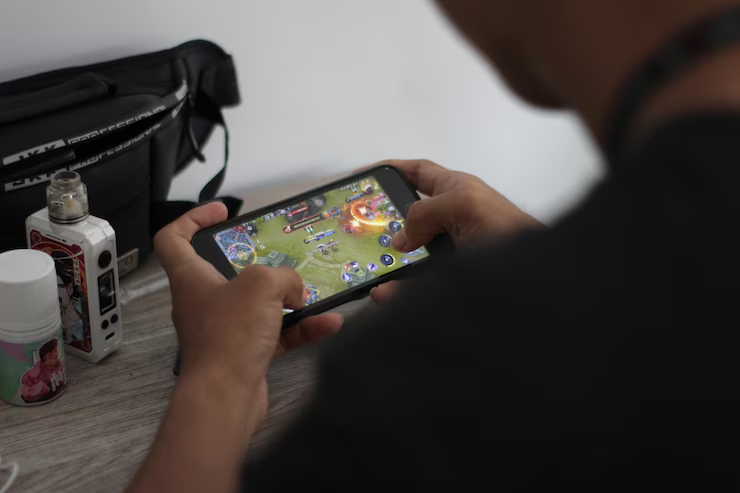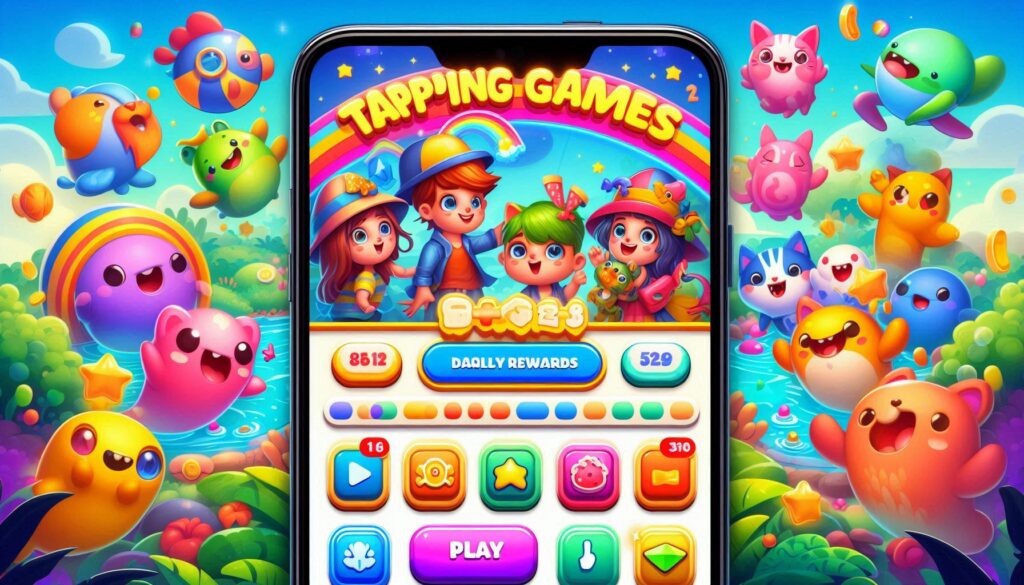
Picture this: You’re on a crowded train, earbuds in, phone in hand, and your fingers are flying across the screen. The world around you fades as you chase that elusive high score, tapping faster than you thought possible. Your heart races, your focus sharpens, and for a fleeting moment, you’re the undisputed champion of a digital universe. This is the magic of tapping games—simple, addictive, and relentlessly challenging. Whether you’re a casual gamer looking to kill a few minutes or a competitive soul aiming for leaderboard glory, tapping games that test your speed have a unique way of hooking you. In this deep dive, we’ll explore the world of speed-based tapping games, their evolution, mechanics, appeal, and why they’ve become a global phenomenon in 2025. From personal anecdotes to expert insights, actionable tips, and a sprinkle of gaming history, this guide has it all. Let’s tap into the fun!
What Are Tapping Games, and Why Do They Obsess Us?
Tapping games, often called clicker or idle games, are mobile or browser-based games where the primary mechanic involves repeatedly tapping the screen to achieve goals, earn points, or progress through levels. Their simplicity is deceptive—beneath the surface lies a carefully crafted balance of challenge, reward, and adrenaline. Games like Flappy Bird, Tap Titans 2, and Speed Tapping Game have captivated millions by testing reflexes, patience, and finger dexterity. According to a 2024 report by Revinfotech, tapping games surged in popularity due to their accessibility and ability to fit into short breaks or long gaming sessions.
I remember my first encounter with a tapping game back in 2014. Flappy Bird was everywhere, and I was determined to navigate that pixelated bird through an endless maze of pipes. My thumbs ached, my eyes stung, but I couldn’t stop. Each tap felt like a personal triumph, and every crash was a lesson in resilience. That’s the allure of tapping games—they’re easy to pick up but devilishly hard to master. Their minimalist design strips away complexity, leaving only you, the screen, and your raw speed. But what makes these games so addictive? It’s the dopamine hit from chasing high scores, the thrill of competition, and the satisfaction of incremental progress. Whether you’re tapping to guide a bird or battling virtual foes, the formula is irresistible.
The Evolution of Tapping Games: From Flappy Bird to Crypto Rewards
Tapping games have come a long way since their early days. In the early 2010s, titles like Flappy Bird and Piano Tiles defined the genre with their straightforward mechanics and infuriating difficulty. These games were solo experiences, pitting you against the game’s escalating challenges. Fast forward to 2025, and tapping games have evolved into social, multiplayer, and even financially rewarding experiences. A SabioTrade blog post highlights how modern tapping games like Sabio Market Titans and Hamster Kombat integrate tap-to-earn mechanics, where players convert taps into real-world rewards like cryptocurrency or trading capital.
This evolution reflects broader trends in mobile gaming. Developers have embraced enhanced graphics, social features, and quests to keep players engaged. For example, Race Clicker: Tap Tap Game combines tapping with racing strategy, requiring players to balance speed and endurance on dynamic tracks. The game’s vibrant visuals and competitive leaderboards make it a standout in 2025, as noted by CrazyGames. Meanwhile, games like Tap of War introduce multiplayer tug-of-war mechanics, where you tap faster than your opponent to claim victory. These innovations show how tapping games have grown from simple time-killers to immersive experiences that blend skill, strategy, and community.
Why Speed Matters: The Psychology Behind Tapping Games
Speed is the heartbeat of tapping games. Whether you’re racing against a 30-second timer in Speed Tapping Game or dodging obstacles in Tap Ninja, the pressure to act quickly is what fuels the excitement. But why does speed resonate so deeply? It’s rooted in psychology. Fast-paced games trigger the brain’s reward system, releasing dopamine with every successful tap or milestone. A Riseup Labs article explains that games like Speed Tapping test not just reflexes but also patience and mental endurance. Scoring over 800 taps in 30 seconds isn’t just about finger speed—it’s about staying calm under pressure.
I’ve had moments where I felt like my fingers were moving faster than my brain could process. During a late-night session of Tap to 100, I was so focused that I barely noticed the rainbow background spinning in sync with my taps. The game’s millisecond timer pushed me to shave off fractions of a second, turning each session into a personal challenge. This intensity is deliberate. Developers use time limits, leaderboards, and escalating difficulty to create a sense of urgency that keeps players coming back. The result? A game that’s equal parts frustrating and exhilarating, with every tap pushing you closer to mastery.
Top Tapping Games to Test Your Speed in 2025
The tapping game landscape in 2025 is diverse, with options for every type of player. Here’s a roundup of the best speed-based tapping games, each offering unique mechanics and challenges:
- Speed Tapping Game: A minimalist masterpiece by Riseup Labs, this game challenges you to tap a red button as many times as possible in 30 seconds. It’s pure, unfiltered speed testing, with a global leaderboard to fuel competition. Available on iOS, Android, and Windows, it’s a must-try for purists.
- Tap to 100: This game, featured on the App Store, is a visual and sensory delight. Tap as fast as you can to reach 100, with a rotating rainbow background and Apple Game Center integration for global rankings. It’s perfect for players who want a quick, intense challenge.
- Race Clicker: Tap Tap Game: A hybrid of tapping and racing, this game requires strategic taps to navigate tracks and outpace opponents. Its vibrant scenery and upgrade system make it a fan favorite on CrazyGames.
- Sabio Market Titans: A tap-to-earn game where players tap to earn Sabio coins, exchangeable for real-world trading capital. It’s a unique blend of speed and financial incentive, as detailed by SabioTrade.
- Tap of War: A multiplayer gem where you tap faster than your opponent to win a tug-of-war battle. Its Notification Center integration makes it accessible for quick play, as noted on the App Store.
These games showcase the variety within the genre, from solo speed tests to competitive showdowns and reward-driven experiences. Whether you’re after raw speed or strategic depth, there’s a tapping game for you.
### Comparison Table: Top Tapping Games of 2025
| Game | Platform | Core Mechanic | Unique Feature | Multiplayer | Battery Impact |
|---|---|---|---|---|---|
| Speed Tapping Game | iOS, Android, Windows | Tap as many times in 30 seconds | Global leaderboard | No | Low |
| Tap to 100 | iOS | Reach 100 taps as fast as possible | Rainbow background, Game Center | Yes | Moderate |
| Race Clicker | Browser, Mobile | Tap to race through tracks | Character upgrades, dynamic terrain | Yes | Moderate |
| Sabio Market Titans | Telegram | Tap to earn coins | Real-world rewards (trading capital) | Yes | Low |
| Tap of War | iOS | Tap faster than opponent | Notification Center play | Yes | Low |
This table highlights the diversity of tapping games, making it easy to choose one that fits your playstyle and device preferences.
Mechanics That Make Tapping Games Addictive
What makes a tapping game impossible to put down? It’s all in the mechanics. Developers use a mix of psychological triggers and gameplay elements to keep players engaged. Here are the key ingredients:
- Time Limits: Games like Speed Tapping Game use short timers (e.g., 30 seconds) to create urgency, pushing players to act fast and stay focused.
- Leaderboards: Global or friend-based rankings, as seen in Tap to 100, tap into our competitive nature, making every session a chance to prove yourself.
- Rewards and Progression: From in-game coins in Sabio Market Titans to character upgrades in Race Clicker, rewards give players a sense of achievement.
- Escalating Difficulty: Games like Flappy Bird start simple but ramp up the challenge, keeping players hooked as they chase mastery.
- Visual and Audio Feedback: Vibrant graphics, like the rainbow background in Tap to 100, and satisfying sound effects amplify the tapping experience.
These elements work together to create a feedback loop that’s hard to escape. I’ve lost count of how many times I’ve told myself “one more try” while playing Piano Tiles 2, only to spend an hour chasing a new high score. The combination of speed, reward, and competition is a recipe for addiction—in the best way possible.
The Benefits of Tapping Games: More Than Just Fun
Tapping games aren’t just about wasting time; they offer surprising benefits. A study by ImproveMemory.org suggests that tapping games can improve hand-eye coordination, reaction speed, and even stress relief. Here’s how they add value to your life:
- Improved Reflexes: The rapid tapping required in games like Tap to 100 sharpens your reaction time, which can translate to better performance in sports or driving.
- Stress Relief: The repetitive action of tapping can be meditative, offering a mental break from daily pressures. I’ve found Lucky Tap to be a great way to unwind after a long day.
- Social Connection: Multiplayer games like Tap of War foster friendly competition, strengthening bonds with friends or family.
- Cognitive Boost: Games with strategic elements, like Race Clicker, require quick decision-making, keeping your brain sharp.
- Real-World Rewards: Tap-to-earn games like Sabio Market Titans offer tangible benefits, such as crypto or trading capital, adding a practical incentive.
These benefits make tapping games more than just entertainment—they’re tools for personal growth and connection. Next time someone teases you for tapping away, you can proudly say you’re training your brain!
Challenges and Downsides: When Tapping Goes Too Far
Like any good thing, tapping games have their downsides. The addictive nature of these games can lead to excessive screen time, especially for younger players. I’ve caught myself playing Tap Titans 2 far longer than intended, ignoring chores or sleep. A GamePix article notes that while tapping games are simple, their accessibility can make it easy to lose track of time. Other challenges include:
- Physical Strain: Rapid tapping can cause finger or wrist discomfort, especially during marathon sessions. Taking breaks and stretching can help.
- In-App Purchases: Many free games, like Best Fiends, offer in-app purchases that can tempt players to spend real money for progress.
- Frustration: The steep difficulty curve in games like Flappy Bird can lead to rage-quitting, especially for less patient players.
To enjoy tapping games responsibly, set time limits, avoid impulsive purchases, and listen to your body. Gaming should be fun, not a source of stress or strain.
Tips to Master Tapping Games and Crush the Leaderboards
Want to dominate your favorite tapping game? Here are actionable tips to boost your speed and performance:
- Optimize Your Grip: Hold your device comfortably, using both thumbs or index fingers for faster tapping. Experiment to find what works best.
- Practice Rhythm: Many games, like Piano Tiles 2, have a rhythm to their challenges. Tap in sync with the game’s pace to improve accuracy.
- Use Lightweight Devices: A responsive touchscreen is key. Older devices may lag, so consider upgrading or cleaning your screen for better sensitivity.
- Warm Up: Before chasing high scores, do a few practice rounds to loosen your fingers and get in the zone.
- Stay Calm: Panic leads to mistakes. Take deep breaths and focus on precision, especially in games like Speed Tapping Game.
- Leverage Boosts: In games like Sabio Market Titans, use in-game boosts or upgrades strategically to maximize your taps.
- Study Top Players: Watch YouTube tutorials or Twitch streams of top players to learn their techniques and strategies.
I’ve found that warming up with a few rounds of Tap to 100 before a serious session helps me hit my stride. It’s like stretching before a workout—small prep goes a long way.
The Future of Tapping Games: What’s Next in 2025 and Beyond?
As we look to the future, tapping games are poised for even more innovation. Developers are experimenting with augmented reality (AR), where tapping could interact with real-world environments, and artificial intelligence (AI) to create personalized challenges. A Hostinger blog suggests that gaming blogs could explore emerging trends like AI-driven gameplay, hinting at the potential for tapping games to evolve. We’re also seeing a rise in tap-to-earn models, with games like Hamster Kombat offering crypto rewards that could become mainstream.
Imagine a tapping game that adapts to your skill level in real-time or one that lets you compete in virtual arenas with friends across the globe. These advancements could redefine the genre, making it more immersive and rewarding. For now, the focus remains on balancing simplicity with depth, ensuring tapping games remain accessible yet challenging.
FAQ: Your Burning Questions About Tapping Games Answered
What makes tapping games so addictive?
Tapping games hook players with simple mechanics, instant feedback, and rewarding progression. The combination of time pressure, leaderboards, and dopamine-driven rewards keeps you coming back for more.
Are tapping games bad for your fingers?
Prolonged tapping can cause strain or discomfort. To avoid issues, take regular breaks, stretch your fingers, and avoid excessive force while tapping.
Can you earn real money from tapping games?
Yes, tap-to-earn games like Sabio Market Titans and Hamster Kombat offer rewards like cryptocurrency or trading capital. However, earnings vary, and some games require significant time investment.
Which tapping game is best for beginners?
Speed Tapping Game is ideal for beginners due to its straightforward mechanics and low learning curve. It’s available on multiple platforms and focuses purely on speed.
Are tapping games battery-intensive?
Most tapping games, like Lucky Tap and Tap of War, are designed to be lightweight and battery-friendly, making them perfect for long sessions without draining your device.
How can I improve my tapping speed?
Practice regularly, use both hands if possible, and maintain a relaxed grip. Warming up and studying top players’ techniques can also boost your performance.
Conclusion: Tap Your Way to Fun and Mastery
Tapping games are more than just a way to pass the time—they’re a testament to the power of simplicity in gaming. From the infuriating charm of Flappy Bird to the rewarding tap-to-earn mechanics of Sabio Market Titans, these games have carved out a unique space in the mobile gaming world. They challenge our reflexes, spark our competitive spirit, and even offer unexpected benefits like improved coordination and stress relief. As we move deeper into 2025, the genre shows no signs of slowing down, with innovations like AR and AI promising to take tapping to new heights.
Whether you’re a casual player or a leaderboard warrior, there’s a tapping game out there for you. Start with Speed Tapping Game for a pure speed test, or dive into Race Clicker for a strategic twist. Whatever you choose, remember to play responsibly, take breaks, and savor the thrill of each tap. Why not grab your phone, pick a game from our list, and see how fast you can go? Share your high scores with friends, challenge them to a tap-off, or explore the tap-to-earn world for some real-world rewards. The world of tapping games is at your fingertips—literally. So, what are you waiting for? Tap in and let the fun begin!











